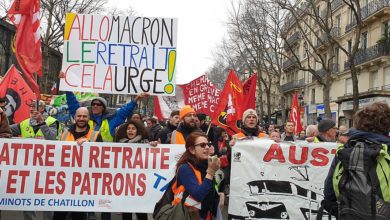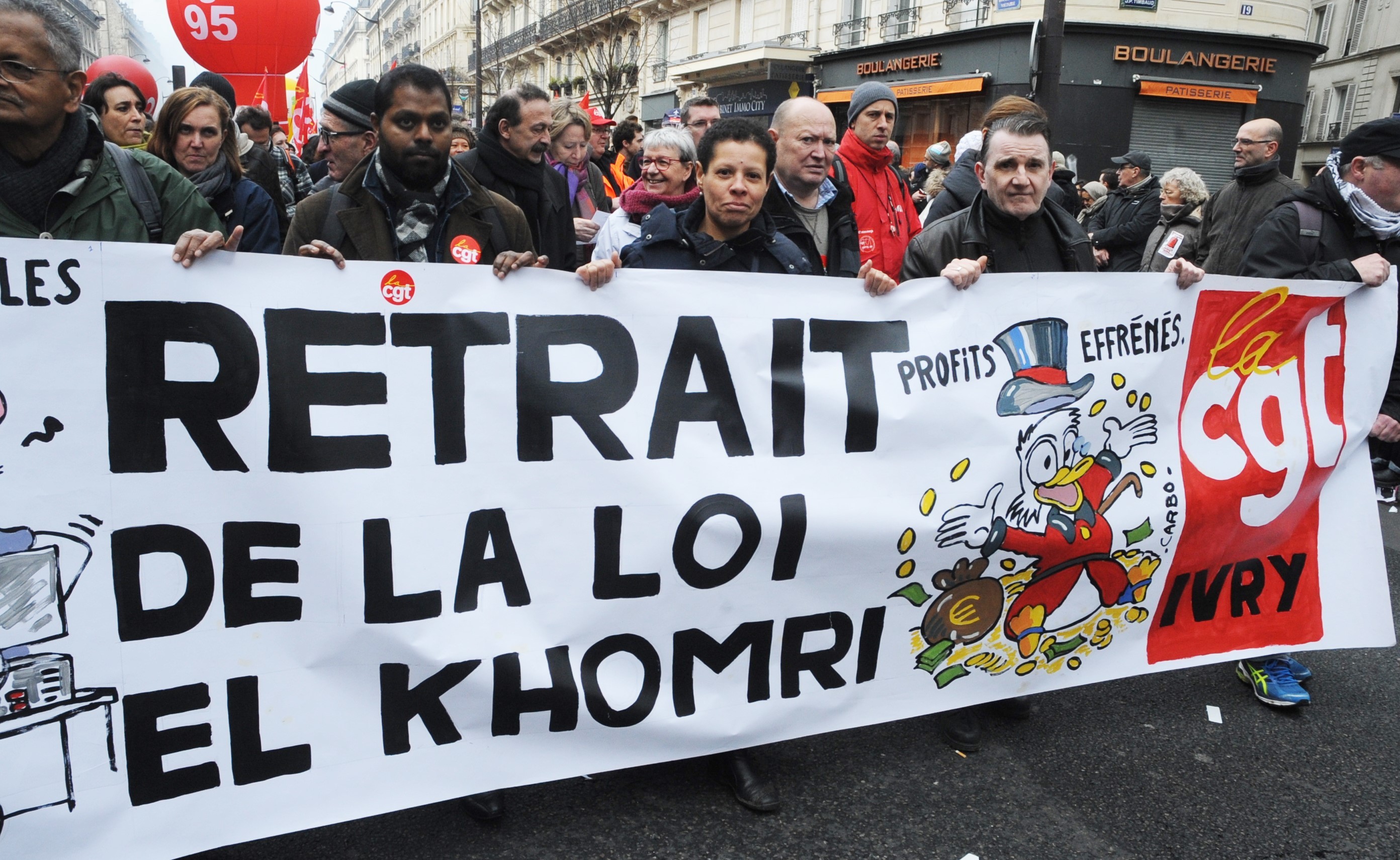 Millions took to the streets to defeat the anti-worker CPE law. Lille, April 4, 2006. Photo: Reuters/Jean-Pierre Rafto |
Two months of massive street demonstrations by students and workers in France resulted in a tremendous victory on April 10. Millions of people came out into the streets in daily protests to force the right-wing government of President Jacques Chirac and Prime Minister Dominique de Villepin to abandon its effort to cut back job security for young workers.
What provoked the class battles was the French government’s attempt to pass a First Employment Contract (CPE). The CPE would give businesses the ability to fire employees under the age of 26 without explanation during their first two years of employment. The CPE is Section 8 of the overall Law for Equal Opportunity, which was adopted in parliament in early February 2006.
Prime Minister Villepin took the lead in promoting the law. He presented it as a way to address unemployment among young workers.
But the French working class and students said otherwise. Beginning in February, students, unions and other forces began to mobilize against the law, chanting, “Resistance, resistance!”
Protests rock the country
The first major protest came on Feb. 7, three weeks after Villepin announced the law. That nationwide demonstration, organized by the major unions, brought out close to half a million people.
Students began to walk out of classes and occupied universities. By the first week of April, half of France’s 84 universities were either disrupted or shut down entirely. Students from over 200 high schools also boycotted classes in protest.
Although widely portrayed in the U.S. press as a student movement, the demonstrations drew in wide sectors of the French working class. Unions played a key role in the demonstrations, as well as all the major leftist political parties.
On March 18, 150 demonstrations took place around the country, drawing up to 1.5 million people. On March 28, mass demonstrations were backed up by transportation workers’ strikes. Organizers reported that 700,000 people came out in Paris alone, and up to 3 million nationwide. The French News Agency called the March 28 protests “one of the biggest demonstrations in modern French history.”
 Students joined trade unions to win. Toulouse, April 4, 2006. Photo: Bordas/SIPA |
On March 28, 3 million protestors took to the streets, and another 3 million demonstrated on April 4. At the same time, public sector workers went on strike, disabling the cities and towns on a massive scale. In coordination with the April 4 protests, millions of private sector workers struck.
While most protests have been militant, several have escalated into near rebellion against the government and police. The police have employed repressive measures against the demonstrations, using riot batons, rubber bullets and tear gas on protestors. Hundreds of protestors were arrested and dozens were injured by police violence.
Throughout the wave of protests, Villepin refused to budge on his support for the CPE, although the government’s knees clearly were shaking. This was first evidenced by Chirac’s initial attempt to modify the CPE. He shortened the period in which young workers could be fired from two to one year and required employees to be notified why they were being fired. But the unions and students rejected the reforms.
Student unions and organizations congregated in Dijon on April 5. What emerged was a list of demands on the government. The demands included the withdrawal of the CPE, stopping privatization of public services, amnesty for all immigrant students, free health care for all students and that the current government step down immediately.
These demands were put into mass action one day later when workers and students blocked streets of French cities. Airplanes were blocked from flying, trains traveling to other countries were halted for hours, and students picketed universities throughout the country.
On April 10, the movement scored a victory for the people. The government totally withdrew the odious anti-worker CPE legislation. Although the bulk of the Law of Equal Opportunity remains intact, including lowering the minimum working age to 14, the replacement of the CPE provision was a huge blow to the government. In its place, Chirac pushed through an employment bill that would give businesses incentives to hire young workers. This reversal shows the power and potential of the united movement of workers and students in France.
A history of struggle
France’s governing party, the Popular Majority Union (UMP) is a conservative, capitalist party bent on pushing anti-worker legislation and cutbacks. It is firmly in synch with the neoliberal economic policies championed by the United States and other European governments.
The root of these policies can be traced to the reactionary governments of capitalist state leaders like Margaret Thatcher and Ronald Reagan, whose policies of takebacks from workers and giveaways to the rich helped peel away rights won decades before.
Chirac and Villepin are now doing their best to live up to their mentors’ and allies’ neoliberal agendas. But every action they take to stamp out workers’ rights is met with the force of organized action.
France has a long history of working-class struggle. Workers in France hold significantly more rights than workers in the United States. They get a minimum of four weeks vacation, better welfare assistance and the right and protection of retaining their job during a strike or protest. But these rights were all fought for and won over decades of battle against the corporate bosses and capitalist state.
In 1936, mass workers’ strikes and factory takeovers shook the foundations of capitalist rule in France. Through the course of the anti-fascist resistance in the 1940s, communists and socialists played a major role. A general strike and uprising in May 1968 paralyzed the country and created a pre-revolutionary situation. Workers and students all came together to oppose the government, French imperialism and the Vietnam War.
All these struggles were pivotal in winning the benefits that French workers now enjoy and that bosses are now trying to take back.
The battle for paid vacation is just one example of many waged and won by French workers and unions. The French capitalist government has been no more willing to give workers social benefits or allow workers’ movements to spring forth than other advanced capitalist governments. French workers have fought long, difficult and bloody battles against the capitalist bosses and their police henchmen. Through these battles, an additional material result has been the building of class-consciousness among workers and youth—the knowledge that the working class has common interests and goals.
Immigrant uprising
More recently, immigrants have added their voices to the overall workers struggle. In October 2005, tens of thousands of youth, mostly of Arab and North African descent, led a mass rebellion that engulfed the country. They were revolting against systematic racism, oppression and police brutality. The electrocution of two North African teenagers, Ziad Benna and Bouna Traore, after being chased by police triggered the uprising.
The brutal legacy of French colonialism in Africa and the Middle East contributed to the justified rebellion. Many immigrants from former French colonies have moved to France to flee economic underdevelopment—a product of the history of colonial rule. This underdevelopment was first imposed under colonialism by brute force and mass murder. Now, it is held up largely by neoliberal economic policies and other forms of imperialist aggression. Immigrants in France face not only racism, but a lack of social services and jobs.
France has one of the highest unemployment rates in the European Union. Among youth, the rate is 22 percent. The unemployment rate is an astounding 44 percent among immigrants and their children, most of whom live in poor urban suburbs.
The recent protests that defeated the CPE bill were not organized explicitly in solidarity with the rebellions of October 2005. Nor did they take up the key demands that emerged from those protests. But they are both products of dissatisfaction with the current capitalist government.
The militancy of the anti-CPE movement also was influenced to some degree by the October rebellion. Racist media outlets and politicians like Interior Minister Nicholas Sarkozy recognized this and attempted to use these organic connections to the bourgeoisie’s advantage. When police cracked down on anti-CPE protesters, they blamed immigrants from the suburbs as being behind the “violence” at these demonstrations.
False smears like this, however, didn’t resonate with much of the workers’ movement. Especially among youth, the plight of immigrants is increasingly seen as a struggle they must support and join. The festering anger of the youth, workers and students goes deeper than the CPE. There is widespread fury at what they see as the lie of the capitalist Republican ideal of liberté, égalité, fraternité—freedom, equality and fraternity.
In France, everyone is supposed to be equal, and equally French. But for ethnic minorities the reality falls far from that ideal. Most young people believe that no matter what university you attend, your chances of a decent job are nonexistent if you have a non-French name or an address in an immigrant suburb.
Continued struggle on the horizon
On the heels of the victorious withdrawal of the CPE, workers and youth are still left with anti-worker employment legislation. The four main student unions and eight trade unions recognize this. In a statement released after their victory, they noted that workers and students now must focus on the repeal of the New Employment Contract (CNE).
The reviled probationary period for employees under age 26 is also part of the CNE, except the CNE applies to workers of all ages who are hired by businesses with less than 20 employees (which make up 96 percent of all French businesses).
The CNE became law in August 2005, and was met with weak resistance from trade unions, although international imperialist institutions hailed its passage. The International Monetary Fund released a paper in October 2005 stating that the CNE “takes an important step toward reforming the employment protection legislation in France.” Since August 2005, an estimated 400,000 workers have signed a CNE contract.
Organizing workers across broad sectors against the CNE is another challenge for the workers’ movement in France. But the primary challenge is how to effectively fuse the spontaneous movement of immigrants with the overall student and worker movement. Together, the workers of France have the power to do what the students demanded on April 5—force the government to step down.
Articles may be reprinted with credit to Socialism and Liberation magazine.





